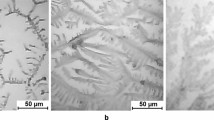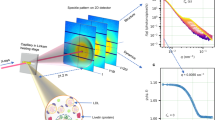Abstract
EMULSIONS and colloidal solutions may be produced by means of ultra-sonic waves1,2. Compounds such as starch and gelatine are depolymerized3,4. It seemed, therefore, of interest to study the action of sonic waves on high-molecular proteins such as the hæmocyanins, the molecules of which are of colloidal size. In the investigation I used hæmocyanin from Helix pomatia, which has a molecular weight of 6,740,000, a sedimentation constant of 99 × 1013 and which, upon change of the pH, gives three dissociation fragments with the sedimentation constants 62, 16 and 12 × 1013 respectively (corresponding to ½, and 116 molecules). These fragments may reversibly recombine to form the original molecule5,6,7.
This is a preview of subscription content, access via your institution
Access options
Subscribe to this journal
Receive 51 print issues and online access
$199.00 per year
only $3.90 per issue
Buy this article
- Purchase on Springer Link
- Instant access to full article PDF
Prices may be subject to local taxes which are calculated during checkout
Similar content being viewed by others
References
Wood, R. W., and Loomis, A. L., Phil. Mag., (7), 4, 417 (1927).
Freundlich, H., Söllner, K., and Rogowski, F., Kolloidchem. Beih., 37, 223 (1933).
Szent-Györgyi, A., NATURE, 131, 278 (1933).
Szalay, A., Z. phys. Chem., A, 164, 234 (1933).
Svedberg, T., NATURE, 139, 1051 (1937).
Svedberg, T., and Hedenius, A., Biol. Bull., 66, 191 (1934).
Eriksson-Quensel, I.-B., and Svedberg, T., Biol. Bull., 71, 498 (1936).
Lundgren, H. P., unpublished.
Author information
Authors and Affiliations
Rights and permissions
About this article
Cite this article
BROHULT, S. Splitting of the Hæmocyanin Molecule by Ultra-sonic Waves. Nature 140, 805 (1937). https://doi.org/10.1038/140805a0
Published:
Issue Date:
DOI: https://doi.org/10.1038/140805a0
This article is cited by
-
Theory of Sonochemistry
Topics in Current Chemistry (2016)
-
Action des ultrasons sur les substances de masse moleculaire élevée
Il Nuovo Cimento (1950)
-
Einwirkungen von Ultraschallwellen auf Hefe
Naturwissenschaften (1943)
-
Recenti ricerche sulle azioni fisico-chimiche ed affini prodotte dagli ultrasuoni
Il Nuovo Cimento (1941)
-
Physikalische Untersuchungen an Eiwei�molek�len
Die Naturwissenschaften (1940)
Comments
By submitting a comment you agree to abide by our Terms and Community Guidelines. If you find something abusive or that does not comply with our terms or guidelines please flag it as inappropriate.



